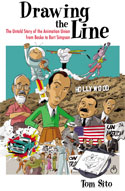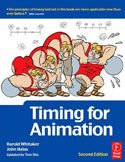|
WGA Strike news December 8th, 2007 |
|

Yesterday major media outlets reported that the negotiations between the Writers Guild of America and the major Hollywood Studios (AMPTP) broke down in rancor. Both sides are now claiming the other is the cause of the impasse. Among the many issues unresolved is the argument over whether the WGA has jurisdiction over animation writers.
In 1939 when the Hollywood studio workers signed their first contracts, animation writing was done on the storyboards. Storymen like Cal Howard, Bill Peet, Mike Maltese, Joe Barbera drew while they wrote and a script was created after the fact for the voice actors. So that year when the National Labor Relations Board was chartering the guidelines for the industry, they awarded the Screen Cartoonists Guild the right to represent all facets of animated cartoon making from writing to finished art. Only camera, editing, music, track and sound engineers were in separate locals. And all came under the aegis of the International Alliance of Theatrical and Screen Engineers, the IATSE. They represent all the Hollywood backstage, except what are called the Glamour Guilds- WGA, DGA, and SAG/AFTRA.
Animation writers are still represented by the Cartoonists Local 839 to this day. Later in 1960's non-artist writers began to create scripts for TV shows and by the late 1980's with movies like Who Framed Roger Rabbit?, American Tale and the Simpsons, scripts done by big time screenwriters became the norm. When animation began to make serious money from these successes, writers began to complain that they wanted to be part of their WGA with it's better benefits and increased residual package. Any residuals earned in the animation union does not go to the individuals, but into the IATSE health insurance package.
Meantime the studios have been making big profits from DVD sales and new media downloads. Writers and Actors have shared as little as four cents on the dollar for any of these lucrative outlets. Management says it's all still too new to be seen as profitable.
When the membership of the WGA voted in President Patrick Verrone and an activist executive board by a landslide, the message was clear that they wanted a showdown with the producers. A number of the WGA board including Verrone worked in animation ( he was a Futurama writer, I believe). Dreamworks Animation studio owner Jeffrey Katzenberg heads the management negotiating team.
I hope something can be worked out for animation writers also. Speaking as someone who has been in negotiations like this before, I think the animation demand is still on the table only because of the intransigence of the employers to budge on the bigger issues like the internet and new media. To resolve the animation jurisdiction the IATSE would have to be brought in the talks. And they are not likely to give up a jurisdiction for nothing. So there is the problem. I am not sure that the animation issue is the chief stumbling block to a deal, but I am not there in person.
From a distance, I admire the unity of the striking writers. Can you imagine a more solitary and individual job like writing? Yet there they are, shoulder to shoulder, rich celeb show-runners, pool writers for big talk shows, and poor unemployables, all together in the streets. Risking it all for a common purpose. It shows us animators how when we stick together instead of going for ourselves alone, we could shake Hollywood too.
So, here we are. Suffice it to say that what goes on in the negotiation room, and what information is leaked to the public are two very different animals. Both sides immediately puts their spin on the details. But it doesn't sound good for a deal before the New Year. I'm hearing the strike is expected to last until April. It's going to be lean times for Tinseltown in the New Year.

|




